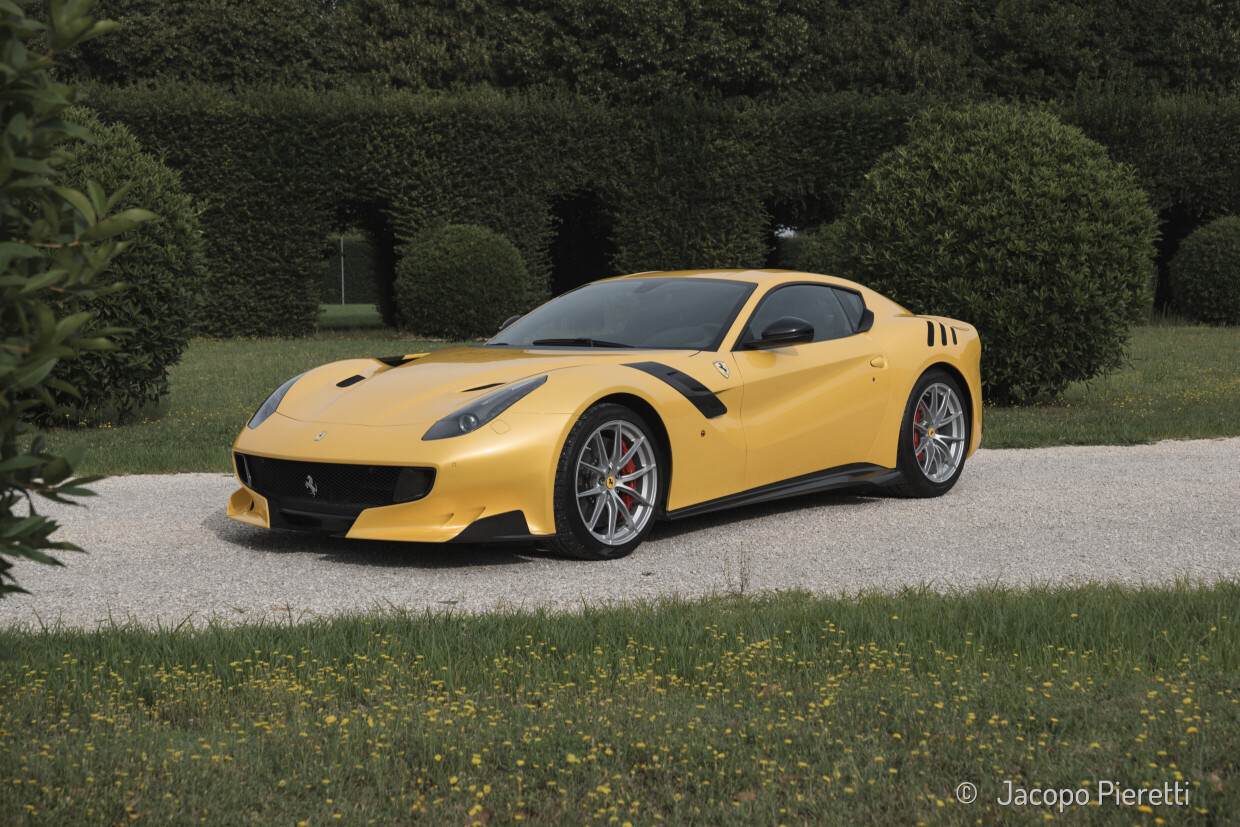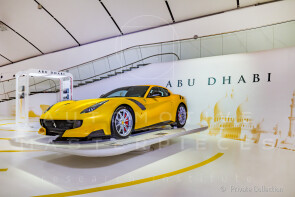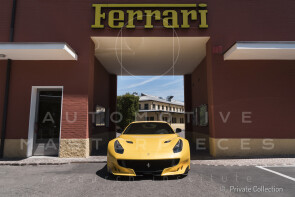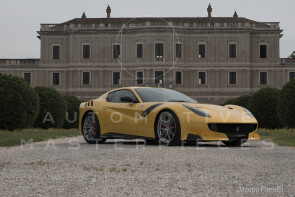
2015 Ferrari F12tdf
ON/OFF
Why am I an Automotive Masterpiece?
L. Limited edition cars
no. 799 manufactured. Example AV0 regarded as a sort of example 0/799.
The Ferrari F12tdf, unveiled in November 2015 at the Mugello Circuit during the Finali Mondiali event, is named in tribute to the historic Tour de France automobile race, a demanding multi-stage competition that became a proving ground for GT cars in the post-war era. Ferrari dominated the event between the mid-1950s and early 1960s with models such as the 250 GT LWB, the 250 GT SWB and the celebrated 250 GTO. The nickname “Tour de France”, though never officially adopted by the factory, became associated with a family of lightweight berlinettas featuring Pininfarina design and Scaglietti coachwork. This evocative name was revived in 2015 for the most radical evolution of the F12 Berlinetta, intended as a spiritual successor to the 599 GTO and conceived for expert drivers seeking a sharper, more track-focused experience. The F12tdf incorporated extensive engineering revisions aimed at reducing weight, increasing aerodynamic efficiency and enhancing dynamic performance. Carbon fiber was employed more broadly across body and interior components, resulting in a significant drop in overall mass. Among the key innovations was the introduction of a rear-wheel steering system, which improved cornering response and agility, especially at higher speeds or during rapid direction changes. The exterior design, directed by Flavio Manzoni, was extensively reshaped to improve airflow and increase downforce, with a reworked front end, a more sculpted rear deck, active aerodynamic elements, and wider tracks front and rear. Together, these modifications made the car markedly more stable and reactive than the standard F12. The V12 engine, based on the unit powering the FF but refined with competition-derived solutions including mechanical tappets and variable-length intake trumpets, delivered 780 hp at high revs with increased responsiveness and greater efficiency. A recalibrated dual-clutch gearbox with shorter ratios and faster shift times enhanced the car’s accelerative character. The chassis layout retained the front-mid engine configuration but featured revised suspension geometry, stiffer settings, and electronic differential management tuned for precise handling. The rear-wheel steering system virtually shortened the wheelbase, contributing to improved rotation in tight bends. Inside, the cabin reflected the car’s purpose, with carbon shell seats trimmed in Alcantara, simplified trim in technical fabrics, and all secondary controls moved to the steering wheel, including the shift paddles, manettino and suspension adjuster. Comfort features were limited, emphasizing weight saving and driving focus. Only 799 examples of the F12tdf were produced, each immediately becoming highly sought-after on the collector market for its blend of heritage, rarity, and advanced engineering. With its raw performance, exclusivity and reference to Ferrari’s endurance racing golden era, the F12tdf stands as one of the most compelling modern tributes to the marque’s motorsport legacy.
Ferrari F12tdf, chassis no. ZFF81BH000211084, known as F12tdf AV0, is the pre-production prototype featuring both the mechanical components and the bodywork of the final model that entered production. Regarded as a sort of “example 0/799,” it is painted in the original Giallo Triplo Strato color and features an interior trimmed in black Alcantara 9440, including seats and detailing. It was used for Ferrari’s most important official events: it made its debut during the Finali Mondiali on November 8, 2015, at the Mugello Circuit, where it was unveiled to the public in a dynamic on-track demonstration driven by Sebastian Vettel and Kimi Räikkönen. The event marked the first public appearance of the F12tdf model, generating great enthusiasm among the audience. In the months that followed, the car appeared in two additional high-profile events in Milan: at the official launch of Ferrari’s listing on the Italian Stock Exchange, held in front of Palazzo Mezzanotte in Piazza Affari, and later at the Milano Design Week, where it was dramatically displayed on the rooftop terrace of the Galleria Sozzani as a symbol of Italian excellence in automotive design. The car was later pictured in official photoshoots for press and advertising purposes. Following these engagements, it was displayed at the Museo Enzo Ferrari in Modena, allowing visitors to admire the unique features of this pre-production prototype as part of the brand’s historical narrative. Next to the car, equipped with a new engine (the current no. *375155*), the original engine (DV 102) was displayed on a pedestal. The car began its assembly on the regular production line but was withdrawn partway through to undergo a special hand-finishing process. The body panels, trim, seals, alignment, and paintwork were all completed manually. While its design matches the production F12tdf, it retains handcrafted features. The rear wheel arches have more pronounced curves, and the air intakes were shaped manually. The interior was also finished outside the standard assembly process. It is powered by a Tipo F140FG V12 engine, serial number 375155, managed by a Bosch MED 9 ECU. The transaxle transmission and differential use a Tipo 4810000518 gearbox, serial number 753. Suspension is independent on all four wheels with a double wishbone layout, BWI–Delphi coaxial spring-damper units, and an anti-roll bar. The Brembo braking system includes carbon-ceramic discs: 380 mm front and 360 mm rear, both ventilated and drilled, paired with red aluminum calipers. The car is fitted with 20-inch alloy wheels: 10" wide at the front with 275/35 ZR 20 tires, and 11J x 20” at the rear with 315/35 ZR 20 tires. It shows extremely low mileage: just 285 kilometers.

![101239192-438a26da-c5e2-479a-9c29-d1a5abe61a25[1]](https://automotivemasterpieces.com/image/3b1c262dba3e5575aef01c06d986dd140529ecb6)


